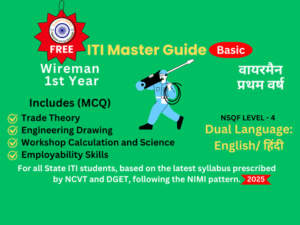Artificial Intelligence
- Description
- Curriculum
- Reviews

Model Question Paper
Artificial Intelligence
Model Question Paper
Artificial Intelligence
Key Features | मुख्य विशेषताएँ
- Bilingual Model Paper | द्विभाषी मॉडल पेपर
- Enough MCQ for Practice | अभ्यास के लिए पर्याप्त MCQ
- Exam Practice Paper with Mock Tests | मॉक टेस्ट के साथ परीक्षा अभ्यास पत्र
- Latest Syllabus as per NEP | NEP के अनुसार नवीनतम पाठ्यक्रम
- Designed by Experts | विशेषज्ञों द्वारा तैयार किया गया
The given MCQs cover only 10% of the syllabus | दिए गए बहुविकल्पीय प्रश्न केवल 10% पाठ्यक्रम को कवर करते हैं।
To cover 100% of the syllabus with summaries, upgrade to our Advanced Model Paper.| पूरा सिलेबस और सारांश कवर करने के लिए हमारा एडवांस मॉडल पेपर जॉइन करें। Join Advanced Model Paper
|
Program/Class: Degree/ B.Sc |
Year: Third |
Semester: Sixth |
||
|
Subject: Computer Science |
||||
|
Course Title: Artificial Intelligence |
||||
|
Course Outcome: The main learning objectives of the course are to: Identify problems where artificial intelligence techniques are applicable. Apply selected basic AI techniques; judge applicability of more advanced techniques. |
||||
|
Credits: 4 |
Core Compulsory |
|||
|
Max. Marks: 25+75 |
Min. Passing Marks: 33 |
|||
|
Unit |
Topics |
|||
|
I |
Approaches to AI: Introduction and Applications, History of AI from Alan Turing and developments in AI, application areas, Criteria for success, Problem Characteristics, Problem representation- State space representation, problem reduction representation, production system, Introduction to agents, intelligent software systems
|
|||
|
II |
Search and Control Strategies: Data driven and goal driven search, Uninformed search- Breadth- first search and Depth- first Search methods, Heuristic Search Techniques- Hill Climbing, best first Search, A*, AO*, Constraint satisfaction and means- end analysis techniques.
|
|||
|
III |
Knowledge Representation: Information and Knowledge, Knowledge Acquisition and Manipulation, Issues in Knowledge Representation, Knowledge Representation methods, Propositional logic and First Order predicate Logic, Horn’s Clauses, Semantic Networks, Frames, scripts and Conceptual Dependencies.
|
|||
|
IV |
Game Playing: Min-max Search Procedure, Adding Alpha -Beta Cut-offs
|
|||
|
V |
Expert Systems: Definition and Applications, Characteristics of Expert Systems, Architecture of a typical Expert System, Expert System shells, Building an Expert System, Expert Systems like MYCIN, Specific Application of AI, Definition of Neurons, Communication and Learning in Neural Networks.
|
|||
|
Program/Class: Degree/ B.Sc |
Year: Third |
Semester: Sixth |
||
|
Subject: Computer Science |
||||
|
Course Title: Artificial Intelligence |
||||
|
Course Outcome: The main learning objectives of the course are to: Identify problems where artificial intelligence techniques are applicable. Apply selected basic AI techniques; judge applicability of more advanced techniques. |
||||
|
Credits: 4 |
Core Compulsory |
|||
|
Max. Marks: 25+75 |
Min. Passing Marks: 33 |
|||
|
Unit |
Topics |
|||
|
I |
Approaches to AI: Introduction and Applications, History of AI from Alan Turing and developments in AI, application areas, Criteria for success, Problem Characteristics, Problem representation- State space representation, problem reduction representation, production system, Introduction to agents, intelligent software systems
|
|||
|
II |
Search and Control Strategies: Data driven and goal driven search, Uninformed search- Breadth- first search and Depth- first Search methods, Heuristic Search Techniques- Hill Climbing, best first Search, A*, AO*, Constraint satisfaction and means- end analysis techniques.
|
|||
|
III |
Knowledge Representation: Information and Knowledge, Knowledge Acquisition and Manipulation, Issues in Knowledge Representation, Knowledge Representation methods, Propositional logic and First Order predicate Logic, Horn’s Clauses, Semantic Networks, Frames, scripts and Conceptual Dependencies.
|
|||
|
IV |
Game Playing: Min-max Search Procedure, Adding Alpha -Beta Cut-offs
|
|||
|
V |
Expert Systems: Definition and Applications, Characteristics of Expert Systems, Architecture of a typical Expert System, Expert System shells, Building an Expert System, Expert Systems like MYCIN, Specific Application of AI, Definition of Neurons, Communication and Learning in Neural Networks.
|
|||







